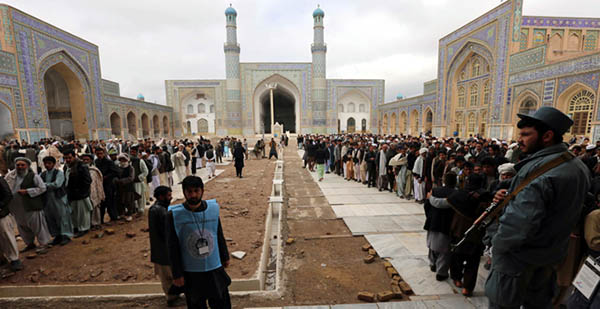KABUL - Despite fears that Taliban violence and suspicions of fraud might put a damper on Saturday's historic elections, Afghans showed-up to polls around the country in numbers that surpassed expectations. With high turnout numbers coming in throughout the day, Afghans and non-Afghans alike celebrated the elections as an overwhelming success.
Independent Election Commission (IEC) Chair Ahmad Yusuf Nuristani estimated in a press conference Saturday night that over seven million Afghans voted in the elections, with a 65 percent male and 35 percent female breakdown. If accurate, that estimate would mean participation in this year's elections was over twice that of the 2009 presidential election.
This 2014 presidential vote marks the first democratic transition of presidential power in Afghanistan's history. Although the complete numbers are not yet in, the indisputably broad participation of both Afghan men and women across the country provided a promising sign for the future of Afghan democracy, which has been led by President Hamid Karzai since the U.S. and its allies ousted the Taliban regime from Kabul in 2001.
As photos and reports of long lines at voting centers around Afghanistan began to spread once polls opened at 7:00AM, the eight presidential hopefuls cast their own ballots, praising their countrymen for defying the Taliban's threats and exercising their democratic rights. By noon on Saturday, election officials said roughly 3.5 million people had already voted.
Militant leaders promised to derail the elections and mounted a surge of violence over the past month targeting election officials, security personnel and journalists. However, on Saturday voters around the country - men and women alike - told media they were not afraid, and voted to show opposition to the insurgents.
Even in some of the country's most restive areas, where experts have said militants hold considerable sway, male and female voters turned out in droves, stretching poll center lines for hours.
Only 211 of the over 6,000 polling centers available nationwide were closed by officials on Saturday due to security threats.
According to local officials in eastern Nangarhar province, out of the two million people living in 22 districts with open polling centers on Saturday, the majority of eligible voters participated. Voters, including many females, lined up in defiance of threats from the Taliban, which has long occupied large swaths of the province that border Pakistan.
In southeastern Ghazni province, nearly 9,000 security personnel were deployed across the province to maintain security on Election Day. Participation was said to be high, and in an exclusive interview with TOLOnews, the Governor of Ghazni said at some polling centers 80 percent of voters were women.
Getting Afghans to vote, but particularly women, was a major initiative of the IEC and civil society groups over the past year. Before Saturday, election officials said they had registered some 3.8 new voters.
In eastern Khost province, another one of Afghanistan's embattled regions, 186 polling stations were operational in the province. Despite threats from local militants, pictures of male and female voters crowding the entrances of polling centers littered social media.
To the south, in Kandahar province, often called the "heartland" of the Taliban, participation was noticeably higher than in past elections. Some estimates put the voter turnout at 80 percent higher than past years, and the entire process was carried out with no major attacks occurring. Polls in Kandahar were some of the last to close, with there still being lines of voters streaming out of centers nearly an hour after their 5:00PM national closing time.
One of the themes of the day, believed to be a result of the high turnout, was ballot shortages. By mid afternoon, a number of polling centers around the country began reporting that they were running short of ballots. The IEC said earlier in the week that it would equip each center with only 600 ballots, in an attempt to stymie ballot box stuffing, which was rampant in the 2009 election.
Western Herat province, which saw an enormous turnout, likely because of its relative distance from much of the militant violence in recent times, was one of the first to begin to complain about ballot shortages. Some local civil society groups even criticized election officials for failing to provide sufficient ballots, arguing that many residents were deprived of their right to vote.
Residents of northern Balkh province, who faced little security threat, were also some of the first to complain about the shortages. According to local officials, 319 polling centers and 1,002 sites were operation on Saturday. 248,000 Balkh voters received voting cards this year out of some 750,000 eligibles.
Officials in Baghlan, Nimroz and Zabul all reported unexpectedly high voter turnout. They said the peaceful environment maintained by the Afghan National Security Forces (ANSF) played a major role.
Although the big story of Saturday's vote was undoubtedly the high turnout in the face of militant threats, a lesser discussed facet of the momentous day was the central role social media played. For news outlets, reporters and average citizens, Twitter and Facebook played a crucial role in getting out pictures and information about lines at voting centers, security and ballot shortages.
With the vote now complete, election officials face the heavy task of counting ballots and determining the elections' winners. Some have said the presidential election could go into a second round of voting, for which the IEC has said it is prepared. (Tolonews)

